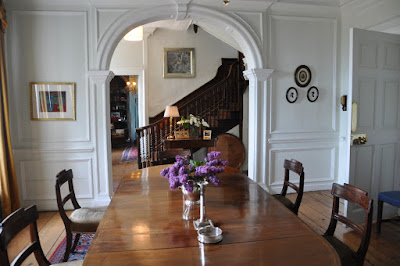George Plumptre stressed that in marked contrast to his rather prim parents Victoria and Albert, who considered horse racing and house parties disreputable and decadent, the Prince of Wales was in his element. With plenty of money and endless leisure time at his disposal, Bertie loved nothing more than lavish house parties for race meetings. High Society of course followed him. The great aristocratic owners such as the Dukes of Westminster and Portland were primarily interested in breeding and owning the best horses of the day. Alfred de Rothschild, for his part, used the racing world as his entrance into respectable Christian society. Well-heeled families looked forward to The Season each year, to put on country house parties themselves or to attend other families’ extravaganzas.
Edwardian guests having afternoon tea
Even architects and garden designers strove to achieve the perfect space for country house properties and their Edwardian social life. As boblatham blog showed, Sir Edwin Lutyens designed a truly exquisite formal garden for the Hon Mr Portman of Hestercombe in Somerset, which he and Gertrude Jekyll completed in 1906. Hertercombe became a stately home much loved for its summer house parties, right in the middle of the Edwardian golden age.
The Prince’s patronage gave racing and country house parties the ultimate imprimatur. Select race meetings - the Derby and Oaks at Epsom (south of London), Royal Ascot (next to Windsor), the Newmarket (near Cambridge) and Goodwood (near Bognor Regis) summer meetings and the St Leger at Doncaster (South Yorkshire) - became major events in the social calendar. In fact the royal nod made racing socially de rigeur. A friendship with the Prince of Wales was the best guarantee of social success.
Women started to be included in the horsy set. Women were expected to be able to talk about racing, to look well dressed at race meetings and to have a good horse seat themselves. But mostly women were to play leading roles in the house parties that became in integral part of life off-course. Competition among hostesses to give the largest and smartest parties and to entertain the most important people was intense. Racing as developed and enjoyed by the Edwardians, on and off the course, achieved its peak patronage by the rich and the aristocratic. It was both a major sporting and a core social event on the Edwardian calendar.
Edwardian Promenade said that the 1860s-1914 era was thought of as the Golden Age of country house entertaining. I agree with her. Popular, but the expense must have been staggering. Parties were usually held from Saturday to Monday; the host and hostess had to supply rooms in their homes for all the guests and the guests’ maids and footmen, three meals a day, all picnic meals at the race track, and their own servants to run this entire enterprise smoothly. In addition, the guests would expect to be offered tennis, croquet, golf, cricket, an outdoor band and an indoor dance.
House party at Ardington House, Oxfordshire with the Prince of Wales.
If the stately home was close enough, guests could arrive by a fleet of carriages. Otherwise it was necessary to go by train. Once guests arrived at the closest railway station, the host family would send servants to meet them and to drive them to the home via horses and carriages. I have no doubt that without the superb network of fast and efficient railways across Britain, country house parties would have been smaller, less extravagant and shorter. In time, the motorcar made it easier to get to country house parties, and then The Fast Set travelled to country homes very easily.
Though racing parties were held during The Season when Parliament was in recess, August and September were the months for country house parties that specialised in shooting. The success of the house party mainly depended upon people knowing one another. This was important for the men out in the field with the guns, and was important to the wives who had to amuse themselves while the men went out shooting. But it might have been tricky, if the host and hostess were not certain who of their guests were sleeping with whom, that year.
Plumptre noted that although shooting was a compulsive hobby for most Edwardian men of this social standing, the women were confined to the house until lunch. Then they were expected to tramp outside and eat either in a draughty tent or, worse still, in the open. After lunch the women were expected to stand silently by their husbands, barracking quietly that their man would bag the most birds. I don’t know what would be worst: the freezing cold feet, the intense boredom or the relentless noise of guns banging.
But even the best of times come to an end; when upper class men became the officers in the trenches of Flanders Field and died by their thousands, The Good Edwardian Life had come to an abrupt end.
Although Blog of an Art Admirer and History Lover focused more on Victorian society than Edwardian, examine the excellent paintings of well heeled Londoners having fun during The Season. Other useful reading includes:
A Member of the Aristocracy Manners and Rules of Good Society
Barstow, Phyllida The Country House Party
Campbell, Lady Colin Etiquette of Good Society
Escott, Thomas Society in the Country House
Gardner, Juliet Manor House: Life in an Edwardian Country House
Girouard, Mark Life in the English Country House
Plumptre, George The Fast Set: The World of Edwardian Racing
Ruffer, Jonathan The Big Shots: Edwardian Shooting Parties






































